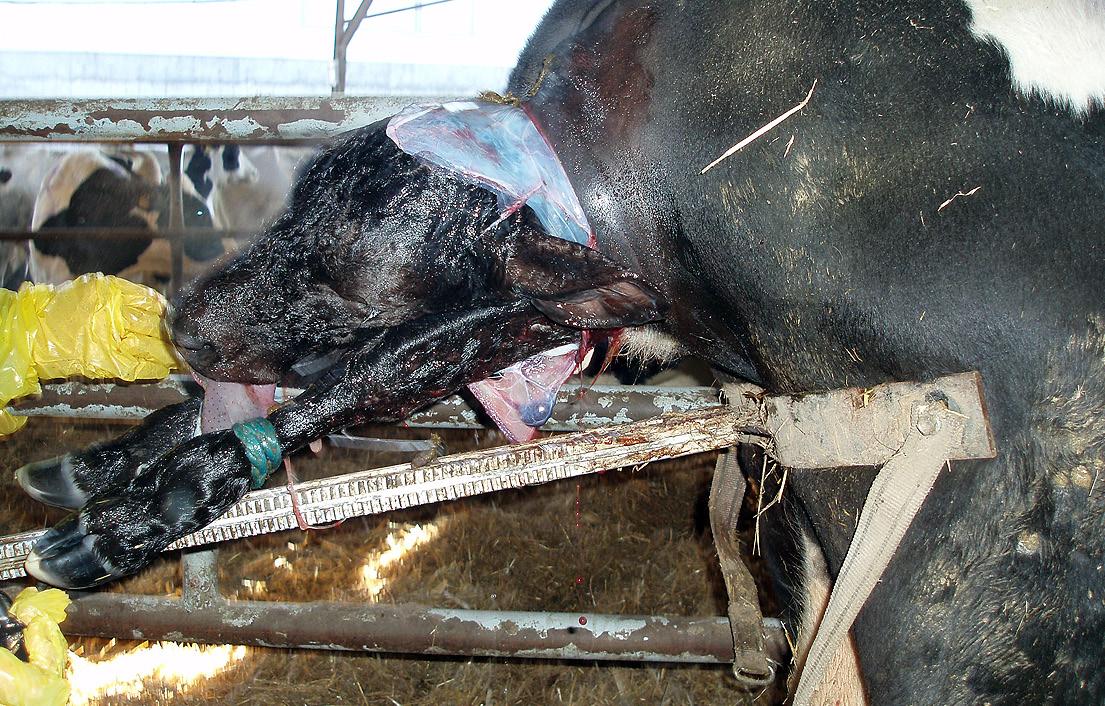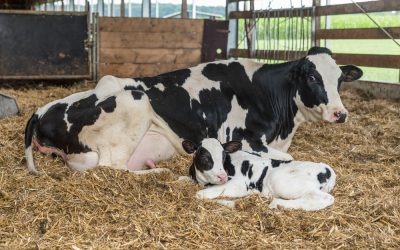D.Temple, E.Mainau, X.Manteca
More information
Download PDF Technical document
A normal calving (eutocia) poses a risk for both the mother and the newborn calf. This risk is greater in the case of a difficult calving (dystocia). Management during the peripartum period can be critical to the mother’s health, and the effects of good management can last into the next lactation period. Likewise, perinatal mortality accounts for half of all deaths in calves before weaning. Thus, the peripartum period involves both welfare issues and potential economic loss, both of which can be mitigated by improving management.
CALVING: A PAINFUL AND STRESSFUL PROCESS
It is generally accepted that giving birth causes acute pain in all species, including cows. Around the time of birth, the levels of acute-phase proteins (such as haptoglobin and serum amyloid protein) increase considerably in response to inflammation, tissue damage and, thus, pain. Dystocia can cause intense pain not only in the mother, but also in the calf.
Any calving also causes physiological stress. The reasons for this are twofold: first, pain is always accompanied by a stress response, and, second, any new or uncommon situation can trigger stress.
The pain and stress caused by calving are important not only because of their negative impact on welfare, but also because they can have significant consequences for the entire birth process, as they inhibit the release of oxytocin, and can therefore decrease myometrial contractions and delay the secretion of colostrum.
DYSTOCIA
In cows, calving usually lasts between 30 minutes and 4 hours from the time the amnion begins to protrude through the vulva to the expulsion of the calf. A calving is considered dystocic if it is excessively protracted or if severe assistance is required to extract the calf.
The two main causes of dystocia in cows are disproportion between the size of the foetus and the diameter of the pelvis (more common in heifers) and malpresentation of the foetus (more common in multiparous cows). Several factors, such as the dam’s diet or the breed of the bull, can affect the risk of dystocia.
In general, dystocia is more frequent in heifers than in multiparous cows and delivery for a heifer is believed to be more painful and stressful. This is due not only to the heifer’s lack of experience, but also to the fact that calving tends to take longer in heifers than in multiparous cows. It is also accompanied by a more pronounced inflammatory response and a slower postpartum recovery.

Dystocic delivery due to a disproportion between the size of the foetus and the diameter of the pelvis
“DYSTOCIA REFERS TO A DIFFICULT BIRTH DUE TO EITHER A PROTRACTED NATURAL BIRTH OR A SEVERE OR PROTRACTED ASSISTED EXTRACTION. IT IS ASSOCIATED WITH UNACCEPTABLY HIGH LEVELS OF PAIN”
BEHAVIOURAL CHANGES DURING CALVING
It is important to be familiar with normal behavioural changes during calving in order to recognise problematic births. The possibility of dystocia should be considered if any stage of the calving is excessively protracted, if atypical behaviour is observed at a given stage, or if changes are observed in the frequency of otherwise normal behaviour. In such cases, it is advisable to monitor more frequently and/or intervene in the calving process.
Phase I |
Phase II |
|
| Description | From dilatation of the cervix to expulsion of the amniotic fluid | From expulsion of amniotic fluid to expulsion of the foetus |
| Approximate duration | 4 hours | 60 -100 minutes |
| Normal behaviours |
The cow looks at its own flanks, kicks, digs the ground and lifts and arches its tail. |
The cow lies in the lateral decubitus or lying position. |
| Contractions | Uterines
Crunches (initially irregular, eventually every 15 minutes, each for 20 seconds at a stretch) |
Crunches (regular every 3 minutes, each lasting 30 minutes) |
| Typical characteristics of normal calving in the cow: stages I and II | ||
Phase I begins gradually, which often makes it difficult to tell exactly when it has begun. A drastic reduction in food intake is one indicator of dystocia and the likelihood of postpartum problems, such as retained placenta, metritis or ketosis. Increased frequency of certain behaviour, such as changes in posture, kicking, scraping the ground or rubbing against the wall, is likewise an indicator of dystocia.
In Phase II, the abdominal contractions are often interrupted, providing some rest. In dystocic calvings, a high percentage of cows will stand before this stage is completed.
In Phase III III (from the expulsion of the calf until the expulsion of the placenta), the dam begins to lick her calf. The degree of difficulty of the calving is reflected in the newborn’s behaviour, as calves will take longer to stand up and to begin nursing after a difficult birth.
MANAGEMENT RECOMMENDATIONS
- Minimise situations liable to cause chronic stress, such as competition for food, water or a place to lie down. Ideally, prepartum pens should include a resting area equivalent to 11m2/cow and a feeding area big enough for all cows to feed at the same time (minimum of 0.76 m of feeder/cow). Additionally, each pen should have at least two water points.
- The cow should be monitored once an hour from the onset of the first stage of calving. Intervention is only necessary if any stage of the calving process is excessively protracted and/or if atypical behaviour, or normal behaviour with abnormal frequencies, is observed.
- Individual calving stalls should be arranged so that the cows within can make eye contact with other cows. This enables efficient monitoring of the calving, as well as proper expression of maternal behaviours in post-parturient dams. Individual stalls should have a surface area of at least 12m2, be fitted with straw bedding or sand, and be hygienic.
- Group calving pens should never hold more than 30 cows each and should be designed to allow cows in labour to be separated without having to be removed from the pen.
- Dams should be allowed to lick and ingest the amniotic fluid on the calf. Not only does this behaviour increase the calf’s vigour, it also helps to reduce the pain caused by the calving in the dam since the amniotic fluid contains certain compounds that enhance the analgesic action of endogenous opioids.
POSTPARTUM CARE
In case of caesarean section or dystocia, use of non-steroidal anti-inflammatory drugs (NSAIDs), alpha-2-agonists (such as xylazine) and/or local anaesthesia (procaine or lidocaine) is recommended. In the case of normal calvings, the administration of an NSAID following parturition can reduce pain and inflammation, improve health and welfare, and help to maintain or increase fertility and milk yield. Scientific data on the impact of analgesics following calving in cows is however limited and often contradictory.
SUMMARY
Calving is a painful and stressful process, especially in heifers and/or cases of dystocia. It is advisable to be familiar with normal behaviour at each stage of calving so as to be able to recognise potential problems. In the peripartum period, competition between cows must be minimised, and the possibility of using palliative pain treatments should be considered.
REFERENCES
- Cook NB and Nordlund KV 2004 Behavioral needs of the transition cow and considerations for special needs facility design Veterinary Clinics of North America: Food Animal Practice 20:495-520.
- Mainau E and Manteca X 2011 Applied Animal Behaviour Science 135: 241-251.
- Mee JF 2004 Managing the dairy cow at calving time Veterinary Clinics of North America: Food Animal Practice 20: 521-546.
- Mee JF 2008 Prevalence and risk factors for dystocia in dairy cattle: a review Veterinary Journal 176:93-101.



